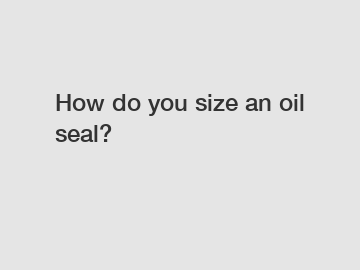How do you size an oil seal?
How Do You Size an Oil Seal?
Oil seals play a crucial role in ensuring the smooth operation of machinery by preventing the leakage of lubricants and the ingress of contaminants. Sizing an oil seal correctly is of utmost importance to ensure efficient sealing and optimal functioning of the equipment. In this article, we will explore the process of sizing an oil seal, including key factors to consider and methods used. So, how do you size an oil seal?
1. Understanding the Basics.

To size an oil seal accurately, one must have a clear understanding of its components. An oil seal typically consists of a metal casing, a sealing lip made of rubber or other elastomers, and a garter spring that helps maintain the sealing lip in contact with the shaft. It is necessary to consider the specific dimensions and material requirements of these components to properly size the oil seal.
2. Identifying the Shaft Diameter.
The first step in sizing an oil seal is determining the shaft diameter on which the seal will be installed. Accurate measurements are crucial in this step, as slight variations in diameter can lead to ineffective sealing or damage to the shaft. Using a micrometer or caliper, measure the diameter at various points along the shaft to account for any irregularities.
3. Selecting the Correct Cross-Sectional Diameter.
Once the shaft diameter is determined, the next consideration is selecting the appropriate cross-sectional diameter of the oil seal. The cross-section refers to the thickness of the sealing lip. It must be large enough to seal the gap while allowing proper contact with the shaft. A seal with too small a cross-section may not create an effective seal, while one with a cross-section that is too large can cause excessive friction and heat generation.
4. Considering Materials and Operating Conditions.
When sizing an oil seal, it is crucial to take into account the operating conditions and type of lubricant being sealed. Different materials are available for the sealing lip, such as nitrile rubber, fluoroelastomer (Viton), or polytetrafluoroethylene (PTFE), each with varying resistance to temperature, chemicals, and wear. Factors like temperature variations, pressure, speed, and the presence of abrasive contaminants should be carefully considered to select the most suitable material for optimal sealing performance.
5. Choosing the Right Lip Design.
Oil seals are available in various lip designs, each catering to specific applications. The most common designs are single lip, double lip, and triple lip seals. Single lip seals are suitable for low-pressure applications, while double or triple lip seals offer enhanced sealing performance and protection against contaminants. The choice of lip design depends on the severity of operating conditions and the level of sealing required.
6. Using a Seal Selector Tool.
To simplify the process of sizing an oil seal, many manufacturers provide online tools known as seal selectors. These tools consider various parameters, including shaft diameter, housing bore diameter, temperature, speed, and fluid compatibility, to recommend the most suitable oil seal for a particular application. Utilizing these tools can save time and ensure accurate seal selection.
In conclusion, properly sizing an oil seal is a critical step in ensuring its effective sealing performance. Taking accurate measurements of the shaft diameter, selecting the appropriate cross-sectional diameter, considering materials and operating conditions, and choosing the right lip design are all crucial factors to consider. By utilizing seal selector tools provided by manufacturers, you can streamline and simplify the sizing process, ultimately leading to the optimal selection of an oil seal for your specific application.
So, how do you size an oil seal? By considering these key points and using the right tools, you can ensure a precise and effective sealing solution to keep your machinery running smoothly.
Are you interested in learning more about China Oil Seal Manufacturers, End Cover Seal, Custom Made Oil Seals? Contact us today to secure an expert consultation!


